When can lilies be replanted: after flowering (autumn) or spring
Lilies are striking flowers that "catch" at first sight with their purity, elegance, beauty. It is no coincidence that we enthusiastically admire the bright colors and enjoy the easily recognizable notes of the so-called symbol of chastity. Many growers successfully grow them in their summer cottages, diligently multiplying them.
- How often to replant lilies?
- When is it better to do this - in spring or autumn?
- What should be the new place in the garden and how to prepare it correctly (what fertilizers should be applied)?
The answers to these and other similar questions will be the subject of this article.
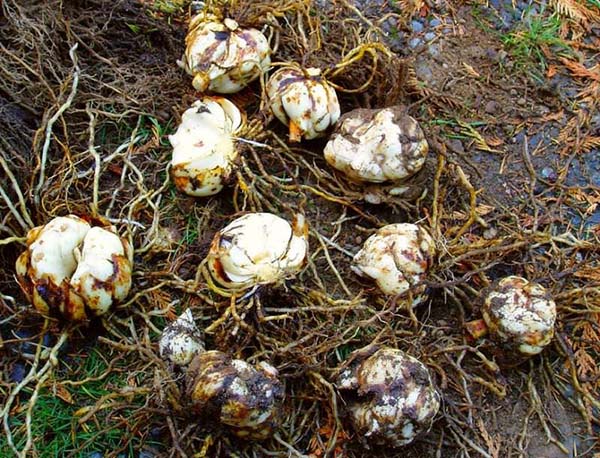
Content
How often should lilies be replanted?
For most varieties of lilies, the period of their active development when grown in the same place, as a rule, is from 3 to 5 years, after which they must be transplanted to another place, because by this time the bulbs grow in the colonies, become very small, and therefore, their flowering ceases to be so attractive and lush.
By the way! Asiatic and tubular lilies require replanting every year.
When to replant lilies: in autumn, summer during flowering, or in spring?
The best time of the year when you can and should transplant lilies from one place to another is autumn.
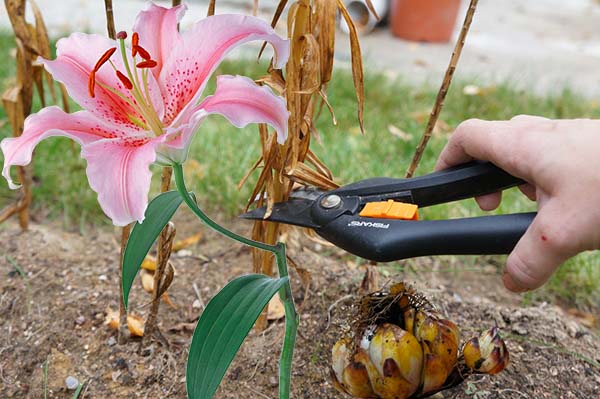
Depending on where you live and what your climate is, the optimal timing for when lilies should be transplanted to a new place are slightly adjusted. So, in the Middle zone (Moscow region) - this is the end of August-early September, for warm southern regions - September-October.
Important! In any case, replanting lilies is necessary only after they have faded. The end of their flowering is just the same falls on August-September. Only it is recommended to do this a month after flowering, so that the bulbs have time to gain mass and in the future take root better.
Advice! And first, do not forget to cut off all the flowers from the plant so that it does not waste extra energy on ripening the seeds.
Video: when to transplant lilies
Is it possible in the summer?
Some varieties of lilies can be transplanted in summer, for example, Snow White or Candidum. She just fades in the middle of summer, that is, in July-August she begins a period of rest, which means it is time to change her place of residence.
Is it possible during the flowering period?
It is believed that Asian hybrid lilies can generally be transplanted all year round, therefore, despite the rather strong harm of such an event to the plant, this hybrid can easily endure it.
Can you replant in spring?
Despite the fact that it is customary to propagate the lily at the end of summer - in the fall, that is, during the dormant period, a fairly large number of summer residents, for various reasons, postpone the transplant of these bulbous flowers in the spring.
By the way! It is best to store lily bulbs in winter in a cellar, while the storage temperature should be not lower than 0 and not higher than +4 degrees. For containers, the bulbs can be folded in boxesor in plastic bagsbut be sure to make ventilation holes... Better yet, shift them furthersphagnum moss.
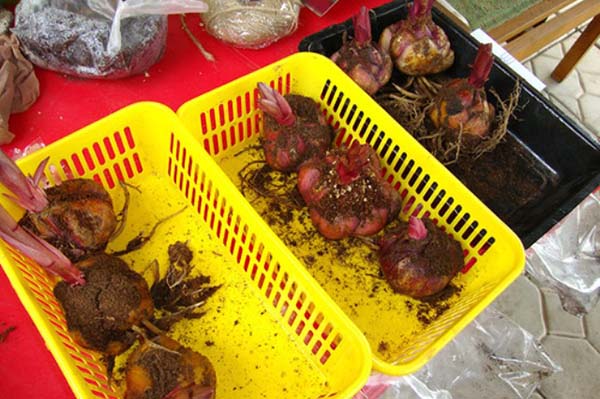
Depending on the region of your residence and climate, as a rule, the optimal terms are the end of April (south), early May (middle zone, Moscow region), the second half of May (Ural and Siberia).
Advice! It is not necessary to store the bulbs until spring. It is quite allowed digging, dividing and replanting lilies just in the spring. The main thing is to have time before the plant begins to drive out the main stem with a bud. If the stem rises to a height of more than 10 cm, then it is better to wait until autumn. Otherwise, the flower will hurt and take root for a long time.

It is most optimal for a spring lily transplant to reproduce by dividing the bush. In other words, you just need to dig up a whole bush and divide it into several (it is better to sort the children separately, so that they can later be planted separately, they will bloom only after 2-3 years), while you do not need to shake off the ground, an earthen lump for each bulb with a stem need to be left, so they will take root better. Then you simply plant each lily at a distance of 15-25 centimeters into the planting hole to the depth at which they were before digging, so to speak, at the level of the previous growth.
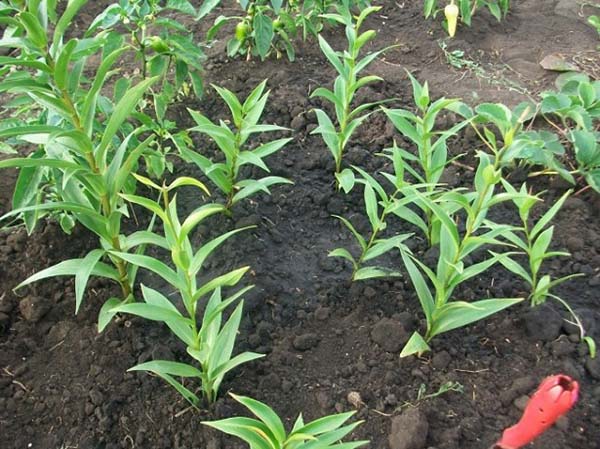
How to transplant a lily to another place: basic rules and step by step instructions
So, the optimal time has come for transplanting a lily. What needs to be done?
A new place in the garden
In order for lilies to bloom luxuriantly and profusely, they must be planted in sunny, calm or well-sheltered areas of the garden. Although they can grow in partial shade, the flowering in this case will not be so bright.
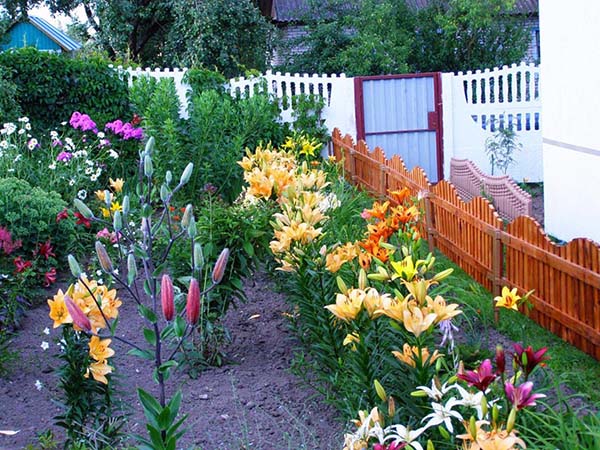
By the way! If you have a small area and there is no more free space, then you can plant lilies in the same place, but you should understand that in this case the likelihood of diseases increases. Therefore, if possible, you need to at least replace the topsoil.
The soil is required to be loose and permeable. Lilies, like all bulbous, do not tolerate stagnant water. Therefore, good drainage is a must. The soil itself must be nutritious and with a neutral acid reaction.
Preparation of planting holes and flower beds
The composition of the nutrient soil (soil mixture) should include peat and sand (or leafy soil in half with humus), and also add as a mineral fertilizer superphosphate (better double) and potassium sulfate.
If you have too acidic soil on the site, then it should be deoxidized, for which you need lime, dolomite flour, you can use wood ash (it is also an excellent potassium-phosphorus fertilizer).

Important! In no case should fresh or insufficiently rotted manure be applied. Such feeding can easily provoke the development of fungal diseases in any bulbs. Only good humus or compost.
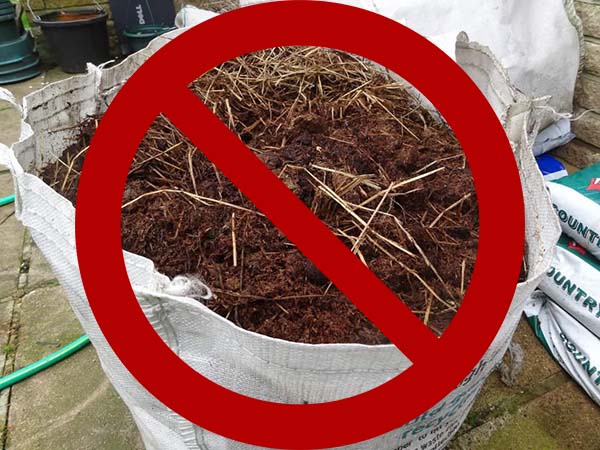
Reproduction methods
There are many different ways of breeding lilies:
- Dividing the nest of bulbs. The point is that each time the mother bulb forms daughter ones, which have their own roots and stems.
- Children. When you dig up the lily, you can find small baby onions between the top of the green stem and the bulb, and it is they that form the bulbous nest over time. The optimal time for planting in open ground is spring (before that it must be stored in the cellar).
- Scales. The most productive breeding method. From one onion, you can get about 20 scales, and from each scale, 2-5 onions. However, not all varieties (with small bulbs) can be divided in this way.
- Cuttings: leaf and stem.
- Bulb. You can find them in the axils of the leaves and on the stem during the flowering period.
- Seeds. It will take more than 5-6 years to wait.
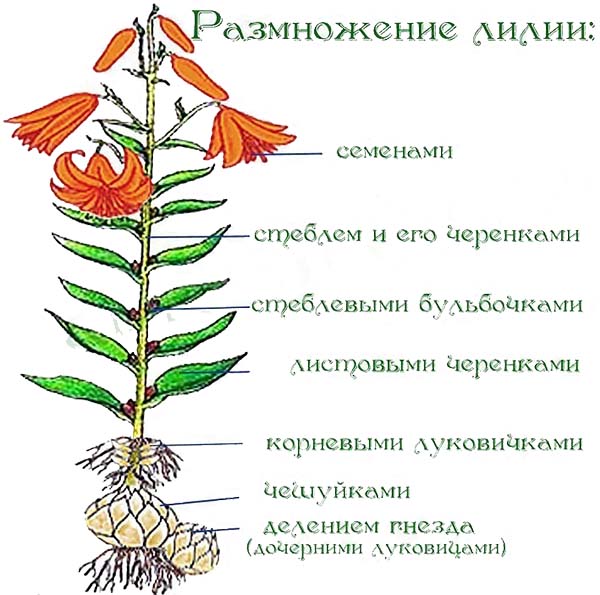
Video: ways of breeding lilies
Further, a step-by-step guide will be presented specifically for dividing the nest of the bulb into daughter bulbs.
Direct transplant process
Step-by-step instructions for transplanting lilies to a new location:
- Wait until the flowering of the lilies ends and 3-4 weeks pass.
- Choose a new location and prepare the ground.
Preparing for transplant: dividing the bulb
- First, you need to remove all flowering shoots (stems), and as close as possible to the surface, almost at soil level.
- Then you need to dig up the lily bulbs.
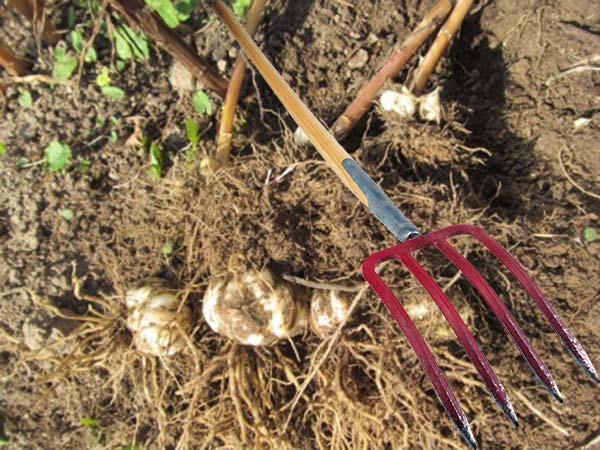
- In order not to damage the future transplant material and its roots, it is best to do this with a pitchfork. A shovel will do, though.
- Next, the bulb must be cleaned of the earth with your hands, and then, if necessary, rinse it in clean water.
- And then you should carefully divide the nest into individual bulbs.
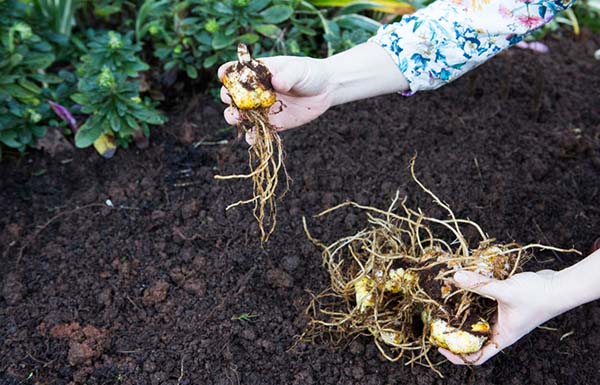
- First you need to remove the stem, it usually comes off very easily.
- Then it is recommended to separate all dead, dried and damaged scales.
- All broken and very long roots are also subject to pruning, you need to leave 15-20 centimeters of healthy roots.
- Now the bulbs need to be disinfected by keeping them for 20-30 minutes in a pink solution of manganese or in any other preparation of a similar action, for example, "Maxim Dachnik".
Planting bulbs
- We make a planting hole with a depth equal to 3 of the height of the bulb. But it is worth considering the size of the peduncles, in other words, tall varieties need to be planted deeper, and for example, the low-growing Snow-white (Candidum) variety is planted at a shallower depth so that the tops of the scales are almost at the surface.

Planting depth and distance between lily bulbs - We make drainage. Pour a small layer of sand at the bottom of the planting hole;
- We put the onion and straighten its roots.
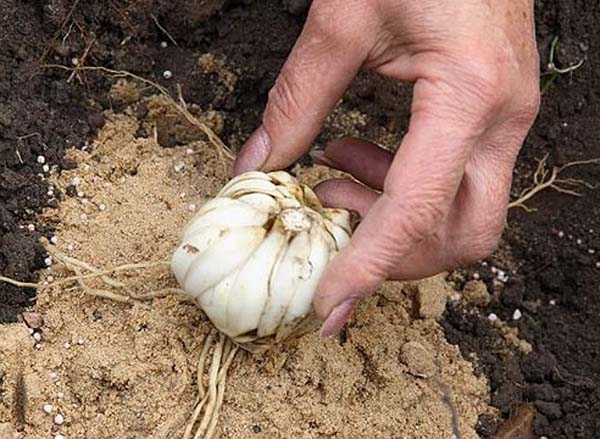
- We fall asleep with nutritious soil.
- We water it abundantly to fill all the voids and the bulb is completely in contact with the ground.
- Mulch, for example with peat.
Important! The distance at which the lily bulbs should be placed should be chosen based on their dimension: large ones are planted after 20-30 cm, smaller ones at a distance of 15-20 cm from each other.
Lily care after autumn transplant
If you live in the middle zone (Moscow region), then after the autumn transplant, when the soil slightly freezes, lilies need to be covered for the winter, spruce branches or dry leaves are best for this, which can be covered with a layer of 10-15 centimeters, and put on top old planks to keep the foliage from being blown away.
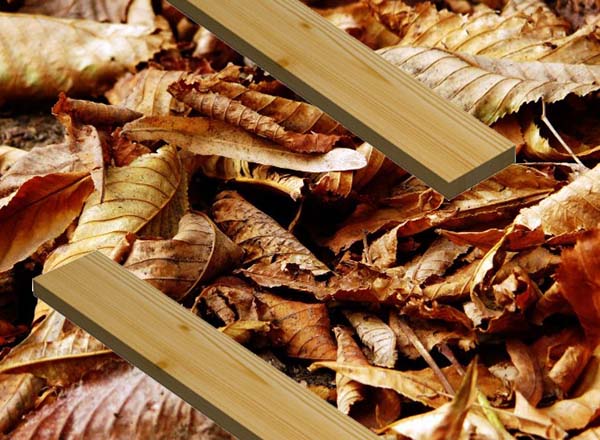
Note! You will find detailed information on caring for lilies in autumn, their preparation and shelter for the winter. in this article.
And with the onset of spring, as soon as the snow melts, the shelter must be removed, and then carefully loosen the soil above the bulbs and carry out the first top dressing to activate the growth of green mass. In most cases, this should be one of the nitrogen fertilizers.
It is very important that young shoots of lilies do not suffer from return frosts in spring, so they should be covered with plastic wrap.
Important! Do not be discouraged if the next year after the transplant the lilies will not bloom very brightly, they need to gain strength and grow. Therefore, try to remove the buds so that the flower does not waste its energy, but rather accumulates them for the next year.
There are no insoluble problems, just as simple now you can cope with the correct lily transplant and proper care after transplanting in the fall.
Video: transplanting lilies in the fall

